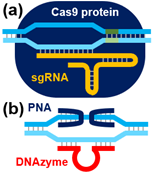Gene Editing/Therapy
Genome editing methods, particularly CRISPR/Cas-based methods (Fig. 1a), have revolutionized modern science, engineering, and medicine, by changing many ways that scientific investigations and clinical applications are carried out. Despite the demonstrated potentials from >10 years of efforts by numerous researchers, issues including immunogenicity, off-target effects and low accessibility on compacted genome regions have limited CRISPR/Cas from reaching its fullest potential. To address these issues, we are developing a novel gene editing method based on nucleic acid-based catalysts, with a mechanism distinct from all other gene editing methods. The method called, PNA-Assisted DNA Nicking by DNAzymes (PANDA, Figure 1b) offers less immunogenicity, higher sequence fidelity, more gene accessibility, stability and programmability for both laboratory and clinical applications.

Figure 1. Schematic comparison of (a) CRISPR/Cas9 and (b) PANDA systems.